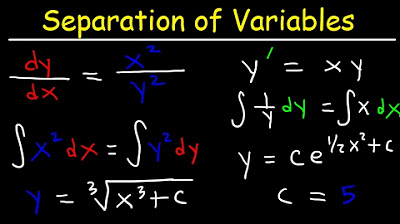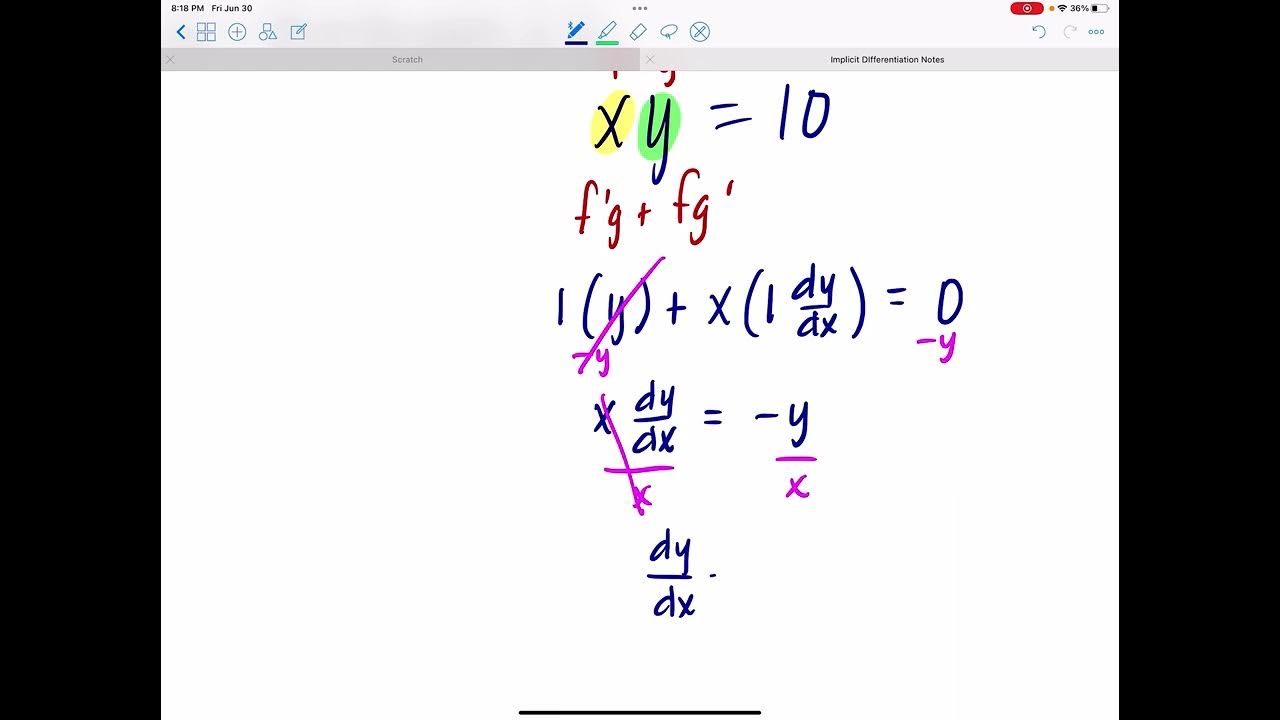Calculus 1: Separation of Variables Examples
TLDRThis video script focuses on the technique of separation of variables, a fundamental method for solving differential equations in AP Calculus AB and BC. The instructor demonstrates how to rearrange a given equation, isolate variables, and integrate both sides to find the solution. They provide a step-by-step walkthrough of an example, including factoring, integrating, and solving for the variable y, resulting in an equation involving exponential functions. The script also highlights cases where separation of variables is not applicable, emphasizing the importance of recognizing when this technique can be used. The instructor concludes by directing viewers to their website for more calculus examples and resources.
Takeaways
- 📚 Separation of variables is a fundamental technique for solving differential equations, particularly for AP Calculus AB or BC.
- 🔍 The goal of separation of variables is to rearrange the differential equation so that all terms involving 'y' are on one side and 'dx' on the other, allowing for easier integration.
- 📝 An example given is the equation dy/dx = y^2 - y, where the process involves moving dx to the other side and isolating the 'y' terms.
- 🧩 Factoring out 'y' and using common denominators is a common step in the separation of variables process, as demonstrated in the script.
- ✅ The integral of 1/y + 1/(1-y) dy is shown to be a natural logarithm, which is a key step in solving the given differential equation.
- 🔢 The integral of dx is simply x, which, when combined with the natural logarithm, leads to the equation involving y and x with a constant of integration.
- 📉 The script explains that the natural logarithm can be exponentiated to both sides to solve for 'y', resulting in an equation of the form y/(1-y) = e^(x+C).
- 🚫 The script also discusses scenarios where separation of variables is not applicable, such as when terms cannot be grouped or isolated to separate 'y' and 'x'.
- 📈 In the context of AP Calculus exams, if a differential equation can be solved using separation of variables, it is expected that students will be able to do so or the solution will be provided.
- 💻 The speaker encourages viewers to visit their website for more examples and step-by-step solutions to over 400 calculus problems.
Q & A
What is the main topic covered in the video script?
-The main topic covered in the video script is the technique of separation of variables for solving differential equations, with a focus on its application in AP Calculus AB or BC.
Why is separation of variables considered a simple technique for solving differential equations?
-Separation of variables is considered simple because it involves basic algebraic manipulations such as moving terms to different sides of the equation and dividing by certain expressions to isolate variables, making it accessible for students in AP Calculus AB or BC.
What is the first step in applying the separation of variables technique according to the script?
-The first step in applying the separation of variables technique is to move the dx term to the other side of the equation and then move all the y variables to one side.
How does the script demonstrate the process of separation of variables with an example?
-The script demonstrates the process by showing an example where dy/dx is equal to y squared minus y, then moving dx to the other side, and factoring out a y to separate the variables, leading to an integrable form.
What integral technique is mentioned in the script for solving the separated equation?
-The script mentions that the integral technique used to solve the separated equation involves taking the integral of both sides, resulting in the natural logarithm of the absolute value of y and one minus y.
How does the script handle the constant of integration in the final equation?
-The script handles the constant of integration by adding it to the right side of the equation and then isolating y to solve for it, using algebraic manipulations.
What is the significance of the natural logarithm in the integral of 1 over y?
-The significance of the natural logarithm in the integral of 1 over y is that it represents the antiderivative of 1/y, which is a standard result in calculus used to solve the integral.
Why is it not possible to use separation of variables on the second example provided in the script?
-It is not possible to use separation of variables on the second example because the terms involving y and x cannot be separated into distinct groups that allow for the dx term to be isolated on one side of the equation.
What advice does the script give regarding solving differential equations on the AP calculus exam?
-The script advises that if a differential equation can be solved using separation of variables, it should be attempted, and if not, the exam may provide a solution to verify.
Where can viewers find more examples and step-by-step solutions similar to those in the script?
-Viewers can find more examples and step-by-step solutions on the speaker's website, which offers free access to over 400 calculus questions.
Outlines
📚 Separation of Variables in Differential Equations
This paragraph introduces the concept of separation of variables, a fundamental technique for solving differential equations, particularly for AP Calculus AB or BC. The speaker explains the process of separating variables by rearranging the equation to isolate 'dx' on one side and 'dy' on the other. The example given involves an equation where 'dy/dx' equals 'y^2 - y'. The goal is to factor out 'y' and separate the variables, allowing for the integration of both sides to solve the equation. The integral of '1/y + 1/(1-y)' dy is derived, leading to a natural logarithm result, which is then solved for 'y' by exponentiating both sides. The speaker also mentions that while this technique is essential for AP exams, more advanced methods are taught in higher-level math courses.
🚫 Inapplicability of Separation of Variables
In the second paragraph, the speaker discusses a scenario where the separation of variables technique cannot be applied to a given differential equation. The equation presented involves 'y', 'x', and their derivatives in a way that prevents the variables from being separated by simple algebraic manipulation. The speaker emphasizes that for the AP calculus exam, if a differential equation can be solved using separation of variables, it will be solvable or the solution will be provided. The paragraph concludes with an invitation for viewers to visit the speaker's website for more examples and step-by-step solutions to over 400 calculus problems.
Mindmap
Keywords
💡Separation of Variables
💡Differential Equations
💡AP Calculus
💡Integration
💡Natural Logarithm
💡Exponential Function
💡Constant of Integration
💡Algebraic Manipulation
💡Factoring
💡Inseparable Differential Equations
Highlights
Separation of variables is a simple technique to solve differential equations.
It is the only technique needed for AP Calculus AB or BC.
The goal is to move dx to the other side and separate y variables.
Example equation dy/dx = y^2 - y is given.
dx is moved to the other side to form dy = (y^2 - y)dx.
Variables are separated by treating the equation like a fraction.
Factoring out y simplifies the equation.
The integral of 1/y + 1/(1-y) dy is the next step.
Integral of dx is simply x.
Resulting equation involves natural logarithms and absolute values.
Integration leads to ln|y| - ln|1-y| = x + C.
Exponential function e^(x+C) is used to solve for y.
Differentiation and algebraic manipulation are used to isolate y.
Separation of variables cannot be applied to all differential equations.
AP Calculus exam may provide a solution to verify if separation of variables is not applicable.
For certain equations, like involving ln(x) and y, separation of variables is not possible.
The instructor offers free access to over 400 calculus questions on their website.
Transcripts
Browse More Related Video

Separation of Variables // Differential Equations

Calculus 1: Implicit Differentiation Examples

SC_V1_1 ODE Trick: Separation of Variables (Leibniz Rule)

Separable Differential Equations (Differential Equations 12)

Separable First Order Differential Equations - Basic Introduction

Implicit Differentiation
5.0 / 5 (0 votes)
Thanks for rating: